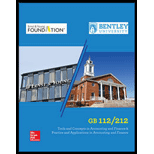
GB 112/212 MANAGERIAL ACC. W/ACCESS >C<
17th Edition
ISBN: 9781260218831
Author: Libby
Publisher: MCG CUSTOM
expand_more
expand_more
format_list_bulleted
Concept explainers
Textbook Question
Chapter 6, Problem 6.2CP
Finding Financial Information
Refer to the financial statements of Urban Outfitters given in Appendix C at the end of this book.
Required:
- 1. How much cash and cash equivalents does the company report at the end of the current year?
- 2. What was the change in
accounts receivable and how did it affect net cash provided by operating activities for the current year? - 3. Which types of customers account for most of the company's accounts receivable? Did
bad debts expense increase or decrease between 2013 and 2014? How did you know? - 4. Where does the company disclose its revenue recognition policy? When does the company record revenues for the “sale” of gift cards?
Expert Solution & Answer
Want to see the full answer?
Check out a sample textbook solution
Students have asked these similar questions
I need help with question is correct answer and accounting
Solve questions and accounting
Solution please accounting
Chapter 6 Solutions
GB 112/212 MANAGERIAL ACC. W/ACCESS >C<
Ch. 6 - Prob. 1QCh. 6 - What is gross profit or gross margin on sales? In...Ch. 6 - What is a credit card discount? How does it affect...Ch. 6 - Prob. 4QCh. 6 - Prob. 5QCh. 6 - Differentiate accounts receivable from notes...Ch. 6 - Which basic accounting principle is the allowance...Ch. 6 - Using the allowance method, is bad debt expense...Ch. 6 - Prob. 9QCh. 6 - Prob. 10Q
Ch. 6 - Prob. 11QCh. 6 - Prob. 12QCh. 6 - Prob. 13QCh. 6 - Prob. 14QCh. 6 - Briefly explain how the total amount of cash...Ch. 6 - Prob. 16QCh. 6 - Sales discounts with terms 2/10, n/30 mean: a. 10...Ch. 6 - Gross sales total 300,000, one-half of which were...Ch. 6 - A company has been successful in reducing the...Ch. 6 - When a company using the allowance method writes...Ch. 6 - You have determined that Company X estimates bad...Ch. 6 - Prob. 6MCQCh. 6 - Which of the following is not a step toward...Ch. 6 - When using the allowance method, as bad debt...Ch. 6 - Which of the following best describes the proper...Ch. 6 - Prob. 10MCQCh. 6 - Prob. 6.1MECh. 6 - Prob. 6.2MECh. 6 - Recording Bad Debts Prepare journal entries for...Ch. 6 - Prob. 6.4MECh. 6 - Determining the Effects of Credit Policy Changes...Ch. 6 - Prob. 6.6MECh. 6 - Prob. 6.7MECh. 6 - Prob. 6.1ECh. 6 - Reporting Net Sales with Credit Sales, Sales...Ch. 6 - Reporting Net Sales with Credit Sales, Sales...Ch. 6 - Determining the Effects of Credit Sales, Sales...Ch. 6 - Prob. 6.5ECh. 6 - Reporting Bad Debt Expense and Accounts Receivable...Ch. 6 - Recording Bad Debt Expense Estimates and...Ch. 6 - Recording Bad Debt Expense Estimates and...Ch. 6 - Prob. 6.9ECh. 6 - Prob. 6.10ECh. 6 - Computing Bad Debt Expense Using Aging Analysis...Ch. 6 - Recording and Reporting a Bad Debt Estimate Using...Ch. 6 - Recording and Reporting a Bad Debt Estimate Using...Ch. 6 - Prob. 6.14ECh. 6 - Prob. 6.15ECh. 6 - Inferring Bad Debt Write-Offs and Cash Collections...Ch. 6 - Inferring Bad Debt Write-Offs and Cash Collections...Ch. 6 - Prob. 6.18ECh. 6 - Prob. 6.19ECh. 6 - Prob. 6.20ECh. 6 - Recording, Reporting, and Evaluating a Bad Debt...Ch. 6 - Prob. 6.22ECh. 6 - Prob. 6.23ECh. 6 - Interpreting tho Effects of Salos Declines and...Ch. 6 - Prob. 6.25ECh. 6 - Prob. 6.26ECh. 6 - Prob. 6.27ECh. 6 - Prob. 6.1PCh. 6 - Recording Bad Debts and Interpreting Disclosure of...Ch. 6 - Determining Bad Debt Expense Based on Aging...Ch. 6 - Preparing an Income Statement and Computing the...Ch. 6 - Prob. 6.5PCh. 6 - Prob. 6.6PCh. 6 - Prob. 6.7PCh. 6 - Reporting Net Sales and Expenses with Discounts,...Ch. 6 - Prob. 6.2APCh. 6 - Determining Bad Debt Expense Based on Aging...Ch. 6 - Prob. 6.4APCh. 6 - Prob. 6.5APCh. 6 - Prob. 6.1CONCh. 6 - Finding Financial Information Refer to the...Ch. 6 - Finding Financial Information Refer to the...Ch. 6 - Prob. 6.3CPCh. 6 - Prob. 6.4CPCh. 6 - Prob. 6.5CP
Knowledge Booster
Learn more about
Need a deep-dive on the concept behind this application? Look no further. Learn more about this topic, accounting and related others by exploring similar questions and additional content below.Similar questions
- What are two double entries the following transaction? Account Receivable. Account payable. Rent Expenses. Cell phone bill, cable, light bill, gas, and monthly income of $4,000.00 what will be your net income after all expenses are paid. Please figure out your own price for each expense.arrow_forwardCan you solve this general accounting problem using appropriate accounting principles?arrow_forwardCan you help me solve this general accounting question using the correct accounting procedures?arrow_forward
- I need the correct answer to this general accounting problem using the standard accounting approach.arrow_forwardI need help solving this general accounting question with the proper methodology.arrow_forwardI need the correct answer to this general accounting problem using the standard accounting approach.arrow_forward
arrow_back_ios
SEE MORE QUESTIONS
arrow_forward_ios
Recommended textbooks for you
 Auditing: A Risk Based-Approach (MindTap Course L...AccountingISBN:9781337619455Author:Karla M Johnstone, Audrey A. Gramling, Larry E. RittenbergPublisher:Cengage Learning
Auditing: A Risk Based-Approach (MindTap Course L...AccountingISBN:9781337619455Author:Karla M Johnstone, Audrey A. Gramling, Larry E. RittenbergPublisher:Cengage Learning Financial Accounting: The Impact on Decision Make...AccountingISBN:9781305654174Author:Gary A. Porter, Curtis L. NortonPublisher:Cengage Learning
Financial Accounting: The Impact on Decision Make...AccountingISBN:9781305654174Author:Gary A. Porter, Curtis L. NortonPublisher:Cengage Learning

Auditing: A Risk Based-Approach (MindTap Course L...
Accounting
ISBN:9781337619455
Author:Karla M Johnstone, Audrey A. Gramling, Larry E. Rittenberg
Publisher:Cengage Learning

Financial Accounting: The Impact on Decision Make...
Accounting
ISBN:9781305654174
Author:Gary A. Porter, Curtis L. Norton
Publisher:Cengage Learning
ACCOUNTING BASICS: Debits and Credits Explained; Author: Accounting Stuff;https://www.youtube.com/watch?v=VhwZ9t2b3Zk;License: Standard Youtube License